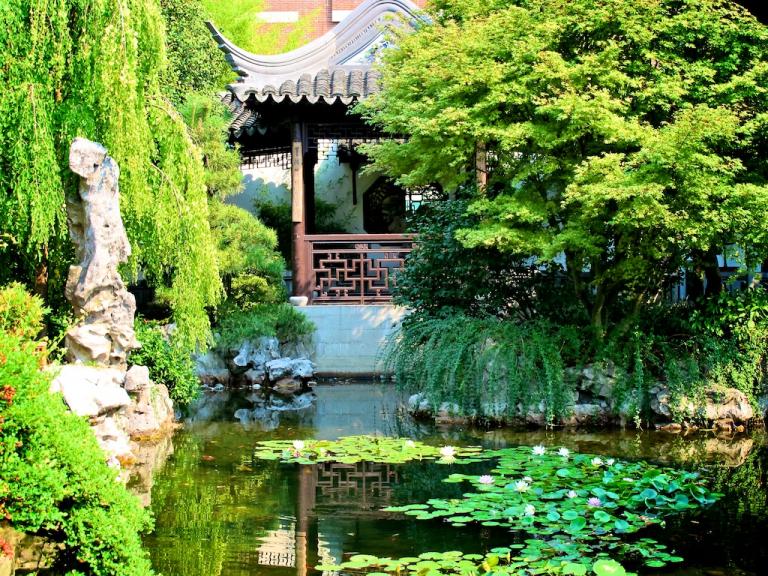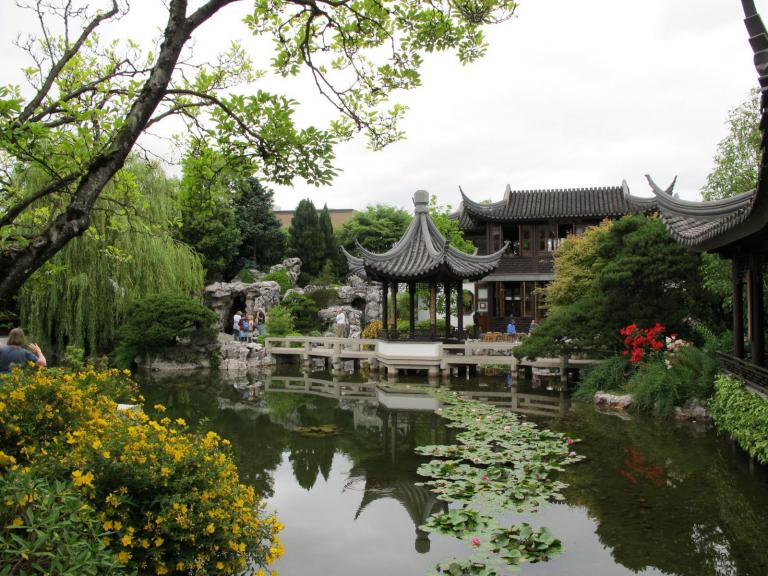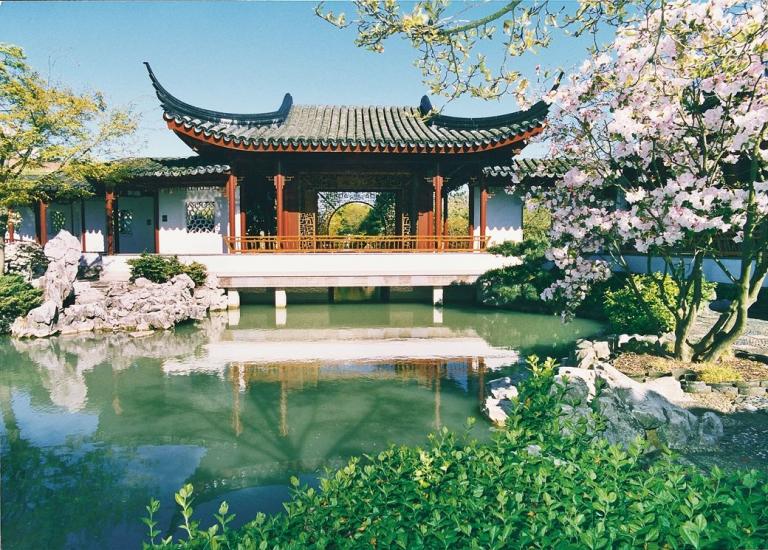TRADITIONAL CHINESE GARDENS
10 min readAlthough they are artificial constructions, they appear to be natural creations. This is very differ ent from the geometric design of European and Islamic parks and gardens Chinese gardens have a number of distinctive characteristics First, they emphasize natural beauty. The basic design principle states that any alteration of the existing terrain should appear to be a creation of nature. This satisfies the human urge to be at one with nature. Structures should not be the main focus, but rather blend in with the surroundings Second, they replicate the freedom and diversity of nature. Although nature has no fixed form, it does follow certain laws. Therefore, the freedom sought in Chinese gardens is not absolute, but rather ex presses a sense of deep natural order. This is totally unlike the classic Western model of garden design, which strives to impose a rigid sense of order upon nature, emphasizing symmetrical layout, ruler straight pathways, uniform beds and ponds, lawns clipped to resemble carpets, and geometrically pruned trees.

Third, they promote artistic appreciation. The beauty of chinese gardens transcends form and composition. They also utilize external structures to express inner emotion, in a blending setting andsensibility. Artistic appreciation is inspired by the overall composition and arrangement of architectural elements, often enhanced by the addition of culturally significant inscriptions and couplets Traditional chinese gardens utilize free composition and visual diversity to create a beautiful and evocative microcosm of nature. Ponds with meandering shorelines, winding paths and unexpected turnings, decorative rocks piled into miniature mountains, artificial grottoes and valleys blend into a scenic retreat as entrancing as a three-dimensional landscape painting. At the end of the 17tn century the famous British garden designer Sir William Temple(1628-1699 AD) had this to say about chinese gardens: “But their greatest reach of imagination is employed in contriving figures, where the beauty shall be great, and strike the eye, but without any order or disposition of parts that shall be commonly or easily observed. Chinese gardens are artfully made in imitation of Nature. (Upon the Gardens of Epicures, 1685 Fragrant Islet in the Humble Administrator’s Garden, Suzhou Chinese gardens appeared as early as the pre-Qin period (pre-221 BC). The Qin-Han period (221 BC-220 AD) and the Sui-Tang period (581-907 AD) were high points in the development of imperial parks and gardens. The Tang-Song period (618-1276 AD) also saw the emergence of private gardens belonging to members of the literati. The Ming-Qing period (1368-1911 AD) saw the synthesis of previous devel opments in garden design. Qing Dynasty gardens are particularly noteworthy, combining the best of the Qin-Han, Sui-Tang, and post-Song periods. almost all existing classical gardens date from this period. The highest concentration of private gardens, exquisitely designed and ingeniously constructed, may be found in the region south of the Changjiang River. Existing imperial gardens, all located in the outskirts of Beijing, are generally impressive large-scale parks. Private gardens of the Ming-Qing period exhibit a higher degree of artistry than imperial gardens The scholar-officials of China’s literati were strongly influenced by the Confucian precept that states,”When in favor at court, strive to help the people; when in disgrace, withdraw to cultivate oneself.
When their work was not going well, they instinctively turned to nature to clear their minds. Private gardens provided them with the perfect meditative retreat. The Confucian concept of seeking equa nimity in nature is very similar to the quest for transcendence advocated by the Daoist philosophers Laozi(c 6th century BC) and Zhuangzi (369-286 BC) and the southern school of Zen Buddhism. The three great Chinese philosophical trends of Confucianism, Daoism, and Buddhism combined to exert a profound influence on the emergence and development of private gardens The private gardens south of the Changjiang River have several distinctive characteristics. First, they belonged mainly to members of the literati, who strove for simplicity, elegance, and refinement above all else. Second, they were relatively small in scale. Landscape gardeners followed the principle of seeing the large within the small “to recreate the vastness of nature within a limited space. Utilizing various design techniques including varying elevations and perspectives, winding sightlines, and cul tural associations, they created profound vistas that inspired deep reflection in the viewer. Third, they were generally constructed around a central body of water, with structures located on all four sides Fourth, they served primarily as places for cultivating the mind andimproving the character, as well as white walls, in order to create a subdued, scholarly atmosphere s dark columns, dark green tiles, and for leisure pursuits. Fifth, they utilized only simple colors, such The Humble Administrator’s Garden in Suzhou (construction started 1509 AD) was originally a simple scholars garden. Most of the current garden was rebuilt during the late 19th century. The main, centralpart of the garden surrounds an oval lake that is oriented on an east-west axis. Two artificial islands and a series of bridges and dikes divide the lake into a series of interconnected pools, with small inlets on the northwest, southwest and southeast corners. The shore is winding and natural, giving a senseof infinite nature. The garden s structures are primarily concentrated on the broad expanse of land along the south bank.
The gate between the residence and the garden is located in the middle of the south wall. Upon entering the garden through this gate, the path first winds around an artificial mountain before suddenly opening up onto a view of the main structure, the Hall of Distant Fragrance. This design technique known as”first conceal, then reveal “adds to the impact of the vista. The hall of Distant Fragrance looks out onto pavilions located on the two islands. There are beautiful views in every direction from every arching bridge frames a beautiful, multilayered waterscape, a boat-shaped structure called Fragrans p where inside the garden Looking north from Little blue Waves Pavilion in the southwestern corner, al Islet extending gracefully over the water.
Looking east from Another World Pavilion, a half-covered pavilion located in the western part of the garden, the view of the lake and Lotus Wind Pavilion is further enhanced by the meanderings of a zigzag bridge laying close to the water. Lotus Wind Pavilion stands at the meeting point of two bridges and one dike, serving both as a scenic focus and a place from which to view the surrounding scenery Looking west from the Secluded Bamboo Pavilion, located in the east of the garden, the Bao’ en Temple Pagoda can be seen in the far distance. This technique of incorporating distant scenery into a garden is called”borrowing a view from afar Shooting Ducks .
The western section of the garden contains a famous walkway that stretches out over the lake on stone piers. The gentle rise and fall of the curving walkway creates a scene as beautiful as a painting Master of Nets Garden(construction started 1795 AD) is the jewel of Suzhou s small gardens. The residence is located in the eastern section, with the main gate at the southeastern corner. The pathway into the garden utilizes the design principle of “first conceal, then reveal. “Only after making several turns and arriving at the exquisite Zhuoying Waterside Pavilion does the view suddenly open onto the broad sparkling lake at the center of the garden .

Low stones line the banks of the lake in an irregular pattern, allowing the water to reach into the crevices, almost like waves lapping against the shore Zhuoying Waterside Pavilion, Moon Comes With Breeze Pavilion, and Shooting Ducks Waterside Pavilion form a triangle on the banks of the lake, each providing a scenic focus as well as a viewing spot for the others. The larger structures are all tucked be hind screens of ancient pines and cypresses in order not to overwhelm the scenic vistas.
Shooting ducks Waterside Pavilion breaks the stretch of wall that encloses the gardens residential area In front of the pavilion is a miniature rockery planted with small trees and bamboo, the tall wall behind it serving as a backdrop for the artistically composed scene The Humble administrator’s Garden and master of Nets garden exemplify the elegance and refine ment of China’s classical private gardens .
Chinas imperial parks and gardens were quite distinct from private gardens. First, they were designed not only to provide a retreat for the imperial household, but also to express imperial power Second they were built on a very large scale, directly incorporating natural mountains and lakes, so location was a key factor. This direct use of nature was similar to realism in painting, as opposed to the sub tle metaphor of private gardens. Third, they made use of multiple scenic focal points. Fourth, their functions and activities were much more extensive and elaborate than those of private gardens. They generally contained both palace halls for governmental functions and residences for the imperial household. Fifth, their use of vivid colors and imposing structures reflected both palace culture and the design aesthetics of northern China, quite unlike the delicate elegance characteristic of the region south of the Changjiang River.
The Summer Palace, (construction started 1750 AD) is built around Longevity Hill and Kunming Lake in Beijing s western outskirts. To the north mountains stretch east and west, and to the south is the lake, creating a triangle that is wide in the north and narrow in the south. The park is divided into four major scenic areas: Area, the Front Hill and Lake Area, the West Lake Area, and the back Hill and Lake Area .
Past the imposing principal palace hall, a narrow winding pathway leads to the Front Hill and Lake Area. Here the vista suddenly opens up, revealing the broad lake and distant mountains, with Yuquan Mountain and its pagoda in the far distance. This is an example of the design techniques”borrowing a view from afar and “first conceal, then reveal .
The relatively uniform silhouette of Longevity Hill is complemented by the majestic Tower of Buddhist Incense and the glazed tile tower behind it The tower of Buddhist incense rises from southern slope of the hill rather than its peak, appearing to be an organic outgrowth of both the hill and the lake. The massive tower is the focal point of the entire park. Below the tower, the Long Corridor, the longest in the world, stretches along the lakeshore for 700 meters from east to west, linking the numerous small structures around the base of the hill .
Looking south from the Tower of Buddhist Incense, one can see the Dragon King Temple island across the lake .
The Front hill and lake area is characterized by its broad and open vistas Unimpeded views of natural water and mountains are like paintings of nature ‘s beauty, rendered in vivid color A long causeway known as the West Dike divides Kunming Lake into two sections, each with an island The West Lake Area is relatively undeveloped and natural. a number of beautiful small bridges are lo cated along the West Dike .
The Summer Palace’s Back Hill and Lake Area is located to the north of Longevity Hill. Winding water ways connect a chain of small lakes and secluded glens line the banks, creating a deep sense of peace and tranquility. a recreation of a Suzhou waterside market is located along the middle section, with pe lod shops lining the banks.
The Imperial Summer Villa in Chengde(constructed 1703-1790 AD) is a mountain resort where the imperial household went to escape Beijing’s summer heat. It consists of four sections. The Lake Area in the east, is the principal part of the garden, containing large and small lakes dotted with numerous slands and islets. The winding shoreline meanders through diverse scenery, rich with the atmosphere of the waterside villages south of the Changjiang River. Various groupings of structures are distributed across the grounds. The Grasslands area, in the north is characteristic of the land north of the great Wall, with wide expanses of grasslands and forest. The Mountain Area in the northwest is the largest section, encompassing three mountain valleys. It originally had several dozen scenic sites, including temples, courtyards, and gardens. The Palace Area, located between the mountain and Lake Areas, is quite small. Its structures are simple and elegant, decorated in muted colors. The terrain of the entire complex is a microcosm of all of china .
Imperial gardens were often decorated with vibrant suzhou style colored painting The ruins of Beijing’s Old Summer Palace(Yuanmingyuan)(construction started early 18 century), was an outstanding example of an imperial garden. However, it was razed by invading foreign armies on two separate occasions. All that remains today are ruins some Western style stone columns, as well s a number of drawings, models, and paintings .
China’s classical gardens have long been admired and imitated around the world. They spread to Japan during the Tang-Song period (618-1276 AD), directly influencing the evolution of Japanese landscape architecture. The 17n century saw their introduction to Europe, where they were copied extensively. However, it did not take long for European gardeners to realize that it was no easy thing to recreate a true Chinese garden. After visiting China, the British royal architect, Sir William Chambers (1726-1796) stated, “The composition of Chinese gardens is extraordinary, creating an ambiance that has long been sought but never achieved in England. The art of Chinese garden design is extremely difficult, and well out of the reach of a person of ordinary intelligence. In China, garden design is a specialized profession, requiring extensive skills. Very few people are able to attain these heights.









